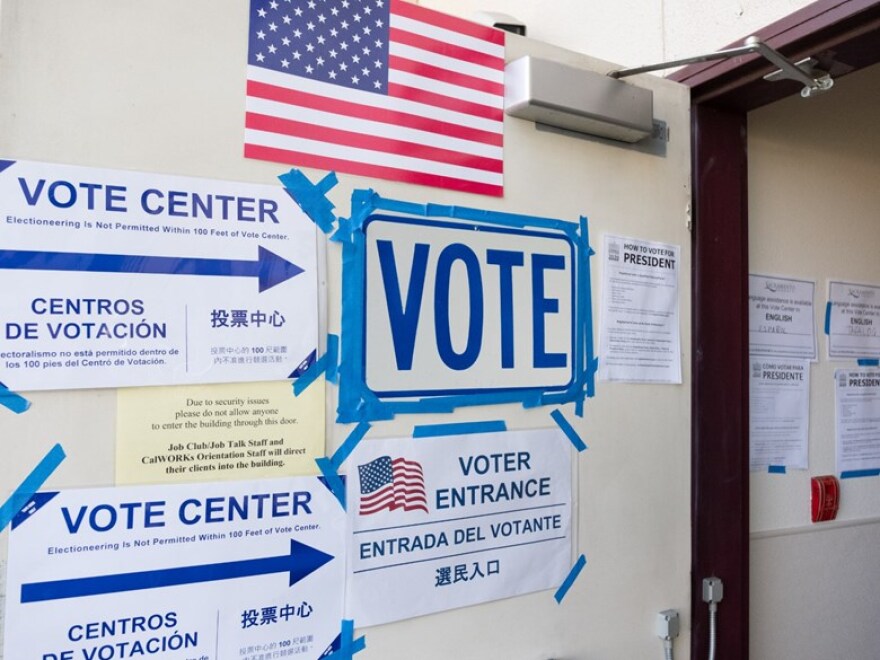More counties in California are moving away from neighborhood polling precincts during the March 3 primary in favor of vote centers, an expanding election model designed to boost voter participation.
Though fewer in number than traditional polling locations, vote centers are open up to 10 days before the election and allow anyone registered in their county to vote in-person or drop off a mail-in ballot.
The new model was established by the Voter’s Choice Act, which was signed into law in 2016. It allows counties to opt-in to the new system and requires them to send vote-by-mail ballots to all registered voters in their county.
Five counties — Sacramento, Madera, Napa, Nevada, San Mateo — piloted the new system in the 2018 midterm election. They are all continuing with it this year. Ten more chose to make the switch for the first time this year: Butte, El Dorado, Amador, Calaveras, Tuolumne, Mariposa, Fresno, Santa Clara, Orange, Los Angeles.
Some vote centers are already open, while the rest open on Saturday.
Kim Alexander, president of the nonpartisan California Voter Foundation, said many of them are former neighborhood polling sites.
“So, for some vote centers it may not actually look that different. But there are far fewer of them. Sacramento County had 600 polling places before we moved to the Voter’s Choice Act and now we have 78 vote centers,” Alexander said. “Generally, you’ll find vote centers located in places like public libraries, community centers, schools, fire stations, churches. Places that can accommodate a lot of voters.”
New Model Aimed At Boosting Voter Participation
Democratic state lawmakers pushed for the new voting model to try and boost voter participation following California’s record low turnout in the 2014 midterm. The legislation, Senate Bill 450, was spearheaded by Sen. Ben Allen, D-Santa Monica, and Sen. Bob Hertzberg, D-Van Nuys.
"This is an opportunity to say: 'We as a state value people voting,'" Assemblywoman Lorena Gonzalez, D-San Diego, said at a news conference in 2015 promoting the bill. "What we need to do is break down all barriers.”
Republican lawmakers opposed it, saying GOP voter turnout rates were already high and that more-competitive elections were the best way to expand voting in the state.
Many Californians Unaware Of Vote Centers
To raise awareness about the new centers, state and local election officials have mailed postcards to registered voters, plastered ads on buses and produced public service announcements. But a poll released last week by the University of Southern California found only 37 percent of likely California voters living in counties that have made the switch, or will do so this year, were able to correctly say their county was making a change.
Red, white and blue ‘Vote Here, Vote Aqui’ banners outside the California Museum in downtown Sacramento clue in passersby about the vote center located inside the museum.
David Allen, an elections volunteer for Sacramento County, is helping out at the museum vote center. He said voters are no longer tied to just one place to vote and don’t have to rush home on election day to cast their ballot.
“In the past, people always end up being stuck at work or even in traffic and can’t quite get there in time,” Allen said. “So, you can do this near where you work. Or your favorite bar or a good friend’s house. Wherever you are, you can drop off your ballot. Or come in and vote your ballot. You know, you don’t even have to have your ballot with you.”
More Services At Vote Centers
Alexander of the California Voter Foundation, which works to inform voters, said there are some services vote centers offer that neighborhood precincts don’t. For example, the centers can look up a voter’s ballot status to determine whether that person has voted or not.
Staff at vote centers can also cancel a previously issued ballot, such as a vote-by-mail ballot, Alexander said. That allows people who walk in to use a regular ballot to vote in-person rather than a provisional one.
At polling places and vote centers, Californians can make last-minute changes this year to their address and party affiliation leading up to and including on election day. Gov. Gavin Newsom signed a new law this month, Senate Bill 207, allowing voters to make those changes faster. It allows them to fill out streamlined paperwork without having to fill out full voter registration forms. Supporters hope the move will cut down on long lines on election day.
To find polling places and vote centers, contact your county elections office or visit the California Secretary of State’s website.
To register to vote online, re-register or check your registration status, visit register to vote.ca.gov. A complete guide for how to vote for president in the California primary is at HowToVoteForPresident.sos.ca.gov.
Copyright 2020 CapRadio


